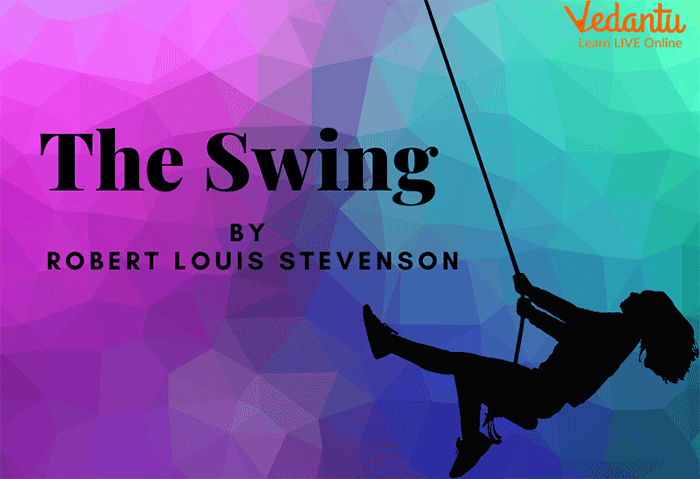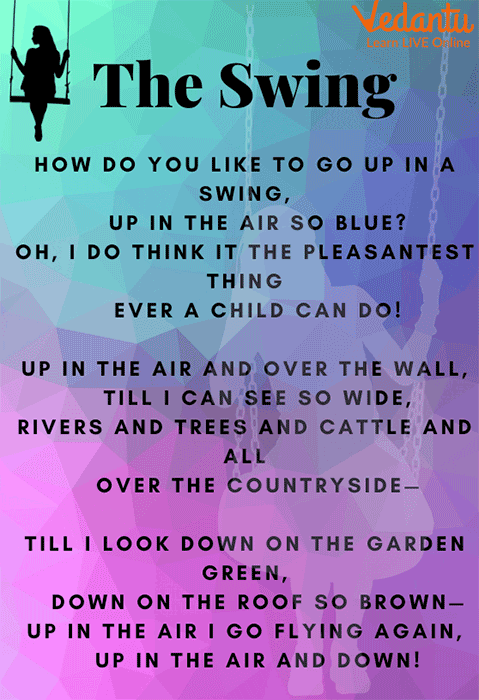The Swing Poem
Have you ever been to the park? What do you do there? Probably take a ride. Ok, then which is your favourite? See-saw or a swing or the giant colossus? Swing — Good choice! What do you feel when you sit on it and enjoy its ride? Do you know the same question asked by a young learner and what the rider replied to him? Read this beautiful poem and find out.
The poem was composed by the great poet Robert Louis Stevenson. We have also provided its explanation and some key points. What are you waiting for? Let's read it aloud!

Poem—The Swing by Robert Louis Stevenson

Poem - The Swing
The Swing Poem and Its Explanation
First Stanza
How do you like to go up in a swing,
Up in the air so blue?
Oh, I do think it the pleasantest thing
Ever a child can do!
Explanation: In the first stanza, the poet begins by asking a question. The question asked by the speaker is very quirky. It shows that the speaker is a young child. The young child excitedly asked what the feeling is when you go up. He was so excited that he could not wait for the listener's response. He answered that it would be the most pleasant thing. He said that the freedom of flying and going up in the blue would be the best thing ever.
Second Stanza
Up in the air and over the wall,
Till I can see so wide,
Rivers and trees and cattle and all
Over the countryside—
Explanation: In this stanza, the listener replies to the tot. He said when I fly up in the forward direction, I can see distant things over the wall. He added that I see rivers and trees over the countryside and a number of cattle.
Here, the poet shared the structured details and position of the swing. From the four lines, the reader can easily understand that the swing is located in a house or boundaries of a firm or park.
Third Stanza
Till I look down on the garden green,
Down on the roof so brown—
Up in the air I go flying again,
Up in the air and down!
Explanation: As the swing started to fall, the speaker said to the tot that when I came down I saw the “roof so brown.” In his upward motion, he saw the countryside. Whereas when he came beneath, he saw dark and familiar structures. Then he again flew up and down.
Here, the poet demonstrates the bouncing motion of the swing. Also, it tells that the swing is in the garden.
Summary of The Swing
In this poem, the poet uses the swing motion with its rhyme. The poem begins when a young child asks a rider about his feelings when he goes up with the swing. The listener responded that it allowed him to see beyond the garden’s wall. Also, he can see the rivers, trees, and cattle in the countryside. And, when he follows the backward direction, he again finds the garden’s green grass. But he enjoyed his ride as he again flew up in the air.
About the Author
Robert Louis Stevenson was a Scottish essayist, poet, novelist, and travel writer. His best works include children’s ‘Classic Treasure Island’ (1882), and the adult horror story, The Strange Case of ‘Dr. Jekyll and Mr. Hyde’ (1886). The Swing was published in the 19th century in ‘A Child's Garden of Verses’ (vol. 64). His work is largely appreciated by the audience and is considered the most influential children’s work.
Conclusion
The poem did not conclude anything real in nature. The poem “The Swing” by Robert Louis Stevenson includes the joy of swinging. And it continued until the swing went up in the air and down.


FAQs on The Swing by Robert Louis Stevenson
1. What did the poet ask on behalf of a little child?
The poet asked a rhetorical question. He asked a question to the person who was sitting on the swing. He questions about how much you like to swing up into the blue air. The inquisitiveness of this question could be easily seen by the quick response of the young child, as he answered himself to the question.
2. How does the swing move?
The swing moved in forward and backward directions. When a child sits on a swing, he uses the motion of his legs to make a swing work. Sometimes, their friends or parents help them to move.





